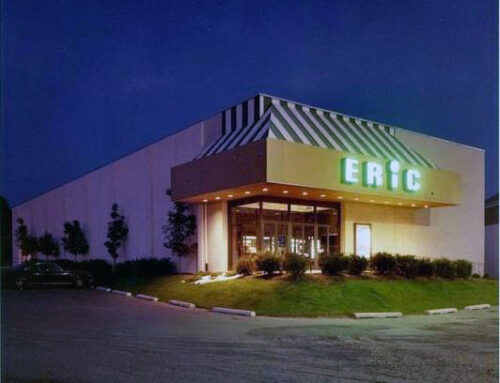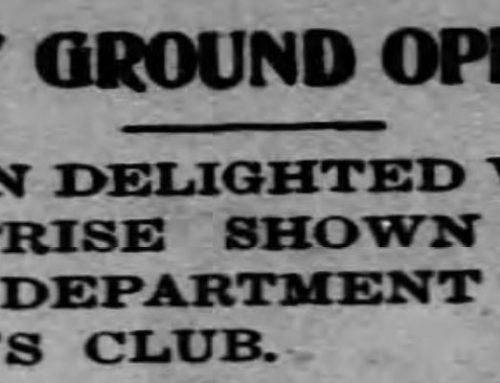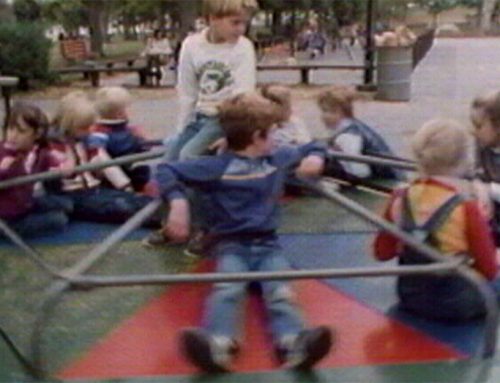Drive-in theaters were hugely popular after World War II and, on special summer occasions featured all-night shows. Among its advantages was the fact that older adults with children could take care of their infant while watching a movie, while youth found drive-ins ideal for a first date. The drive-in’s peak popularity came in the late 1950s and early 1960s, particularly in rural areas, with some 4,000 drive-ins spread across the United States.
The Reading Drive-In, which was located at Berkley Road and Route 222 in Muhlenberg Township, was the first to open in on Aug. 1, 1949. It had a capacity for 744 cars. Projection was on a screen towering 80 feet. Sound was transmitted to individual cars through speakers which were lifted from standards at each parking spot and placed on the car’s partly opened window or door frame. Each grey metal speaker had its own volume control. When closed in September 1982, it had been operated as a Richard A. Fox theatre, one of many under his ownership.
Below: Image Gallery of Reading Drive-In – Click or Touch Image
The Reading Drive-In was followed in 1950 by the Mount Penn Drive-In. Located on the southeastern side of Reading, it opened as the Rajah Drive-In when it was operated by Jay Emanuel Theaters. By 1951 it had been renamed Mt. Penn Drive-In and was operated by Jay Emanuel Theatres and Fabian Theaters.
Below: Image Gallery of Mount Penn Drive-In – Click or Touch Image
The Sinking Spring Drive-In, which opened in 1955, was the third in Berks to be built in the post-World War II heyday of America’s love affair with the car. When it was built by Fabian and Jay Emanuel Theaters, its owners said the screen, 86 feet high and 142 feet wide, was the largest in the world. It contained a 6,700-square-foot parking area capable of accommodating more than 1,000 cars. Located on the south side of Route 422 traffic driving eastbound on Route 422 from Wernersville could see the screen for nearly a half a mile away. There was a patio between the projection room and the concession stand where there were dances, contests and outdoor seating for the movies.
Below: Image Gallery of Sinking Spring Drive-In – Click or Touch Image
The Sinking Spring Drive-In and its older sisters – the Mount Penn Drive-In on Route 422 in Exeter Township and the Reading Drive-In along Route 222 near Temple were part of a theater chain of Reading-based owner Richard A. Fox who moved to Reading from Buffalo New York in 1958 with his family and began his career in motion picture exhibition. Richard Fox purchased the Sinking Spring Drive-In after the former owners decided not to renew its lease. Within two years he had purchased the Mount Penn Drive-in and the Reading Drive-In. These theaters became the keystone of Fox’s chain, which later spanned from Reading to Florida.
The 222 Drive-In, located on Route 222 in Fleetwood, specifically at 8832 Allentown Pike, was opened in 1975 and had a capacity for 300 cars.
Below: Image Gallery of 222 Drive-In – Click or Touch Image
The early 1960s were a golden age for drive-ins. They were more than simply theaters. Each one had a playground. The Reading Drive-In had a miniature railroad ride. Several had trampolines. At the Mount Penn Drive-In, a sunrise service was held atop the concession stand on Easter morning. The Sinking Spring had its own peculiar appeal because of its recessive terrain. The drive-in, like most of Sinking Spring, is built on a limestone spring. The bubbling waters result in numerous sinkholes throughout the area. One of those holes presented itself on opening night in 1955, causing the floor of the concession stand to drop three feet. Entire light poles sunk into the earth.
Drive-In theaters become less popular in the 1970s as they switched from first-run Hollywood fare to exploitation films, and by the time home video started appearing, it was the end for the height of the drive-in.
The Mount Penn Drive-in was operational until the late-1970s when the drive-in was demolished to build a K-Mart. One would enter from the back, travel about 100 yards to the ticket booth, and turn left into the parking/viewing area.
The Reading Drive-In screen, along Route 222 at Temple, burned in June 1984. The Reading Drive-in was replaced by the Sam’s store.
The Sinking Spring Drive-in closed in September, 1986. The 17-acre lot would have been snapped up by a real estate developer looking for someplace to put another office park or shopping mall but in 1989 a remarkable renaissance began. Donald Fox, a 34-year-old theater executive whose family owned the place, who drove past the deserted theater every day on his way to work, reopened the Sinking Spring Drive-in based on a series of hunches. He was guessing that his contemporaries might be coaxed back to the drive-in to share a bit of the past with their children. He was guessing that teenagers who’d never been to a drive-in might wonder what all the excitement was about. He was guessing that first-run movies might make a difference. But the key to the comeback may have been a witty advertising campaign stressing “the return of an American tradition.” The campaign consisted primarily of newspaper ads, but was highlighted by a newsletter with a now-infamous plug for safe sex: “Better safe than sorry. ‘Wrap that Rascal.’ Condoms Available in Restroom.” On its opening weekend, the Sinking Spring Drive-In took in more money on the Clint Eastwood bomb “Pink Cadillac” than any theater outside New York City. At first Fox thought it might be a fad, but “Batman” and “Lethal Weapon 2” did even better and “Ghostbusters II” drew an overflow crowd. By late August, the theater was averaging about 1,500 patrons per week.
The death of the drive-in came as real estate prices rose in the suburbs, walk-in theaters were built, and video rentals rose in popularity. The 222 Drive-In closed in 1996. The era of this unique entertainment form came to an end when the last of the drive-in movie screens in Berks County was demolished. On Tuesday, March 24, 1998, crews took a wrecking ball to the massive 1950s-era Sinking Spring Drive-In theater screen, once billed as the largest in the world, along Route 422 in South Heidelberg Township. Before it was razed, the site of the Sinking Spring Drive-In was used for a flea market on weekends. The site of the former Sinking Spring Drive-In was used for the construction of more than 85,000 square feet of retail space, including a 51,000-square-foot Redner’s.































Leave A Comment